The Data Masking Technology Market is estimated to be valued at USD 1.2 billion in 2025 and is projected to reach USD 4.5 billion by 2035, registering a compound annual growth rate (CAGR) of 14.7% over the forecast period.
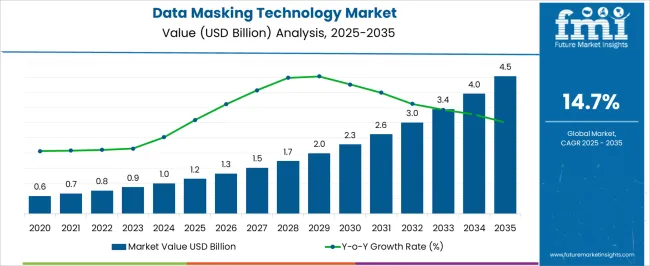
| Metric | Value |
|---|---|
| Data Masking Technology Market Estimated Value in (2025 E) | USD 1.2 billion |
| Data Masking Technology Market Forecast Value in (2035 F) | USD 4.5 billion |
| Forecast CAGR (2025 to 2035) | 14.7% |
The Data Masking Technology market is witnessing robust growth, driven by the increasing need to protect sensitive information and ensure compliance with data privacy regulations across industries. Organizations are adopting advanced masking solutions to secure personally identifiable information, financial records, and confidential enterprise data while enabling safe use for testing, development, and analytics purposes. Growing regulatory pressures, including GDPR, CCPA, and industry-specific standards, are accelerating deployment across both large enterprises and mid-sized organizations.
The integration of masking technologies with cloud, big data, and AI-driven analytics platforms is further enhancing operational efficiency and security. The market is also benefiting from rising digital transformation initiatives, which increase the volume and complexity of data requiring protection.
As enterprises prioritize governance, risk mitigation, and secure data sharing, investments in scalable and flexible data masking solutions are expected to expand Continuous innovation in masking techniques, dynamic data obfuscation, and automation capabilities is further driving adoption, positioning the market for sustained growth in the coming decade.
The data masking technology market is segmented by end-user vertical, deployment models, and geographic regions. By end-user vertical, data masking technology market is divided into BFSI, Retail, Telecomm, Health Care, Energy, Education, Automobile, Public Sector, and Others. In terms of deployment models, data masking technology market is classified into ETL, In-Place Masking, and Dynamic Masking. Regionally, the data masking technology industry is classified into North America, Latin America, Western Europe, Eastern Europe, Balkan & Baltic Countries, Russia & Belarus, Central Asia, East Asia, South Asia & Pacific, and the Middle East & Africa.
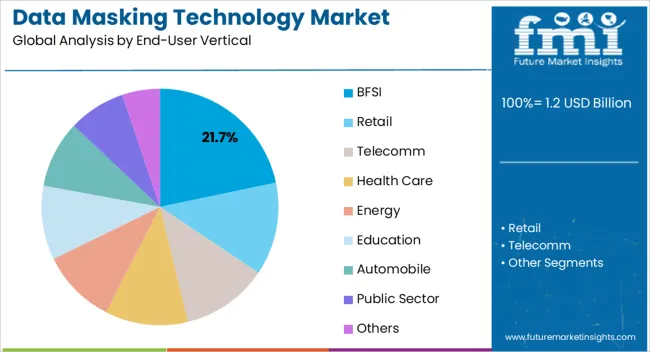
The BFSI end-user vertical segment is projected to hold 21.7% of the market revenue in 2025, establishing it as the leading vertical. Growth in this segment is being driven by the critical need to secure financial data, including customer account information, transaction histories, and sensitive corporate records. Data masking enables organizations in banking, insurance, and capital markets to comply with strict regulatory frameworks while supporting secure testing, analytics, and software development activities.
The adoption of advanced masking solutions allows financial institutions to maintain operational efficiency without exposing sensitive information to internal or external risks. Increasing investment in digital banking, mobile platforms, and financial technology initiatives has further accelerated demand.
With the rising importance of data privacy, risk mitigation, and compliance auditing, the BFSI vertical continues to prioritize data masking as an essential component of IT infrastructure The scalability and flexibility of modern masking solutions ensure that BFSI institutions can meet evolving security and regulatory requirements while maintaining business continuity and customer trust.
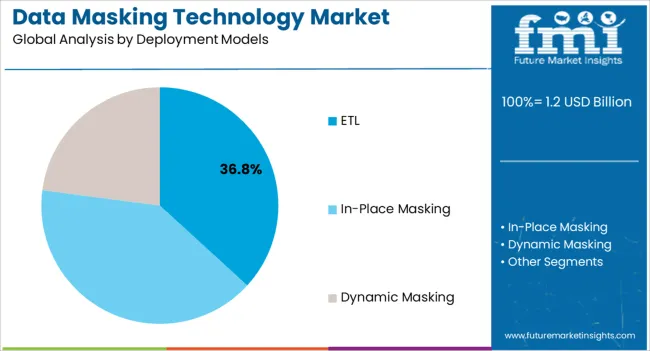
The ETL deployment model segment is anticipated to account for 36.8% of the market revenue in 2025, making it the leading deployment category. Growth is being driven by the increasing reliance on ETL processes to extract, transform, and load sensitive data across multiple systems for analytics, reporting, and enterprise applications. Data masking integrated into ETL workflows ensures that confidential information is protected during processing, enabling secure access for testing, development, and business intelligence operations.
Organizations benefit from automated masking within ETL pipelines, which reduces manual effort, accelerates processing times, and mitigates risk of exposure. The model also supports scalability and adaptability across cloud, on-premises, and hybrid environments.
As companies handle growing volumes of structured and unstructured data and face stricter data privacy regulations, ETL-based masking deployment has emerged as a preferred strategy Continuous innovation in masking algorithms, integration capabilities, and automation ensures that ETL deployments remain critical in securing sensitive information, supporting compliance, and enabling efficient data utilization across enterprises.
The data masking technology market is growing as industries ranging from BFSI to government are becoming extremely cautious to the internal hacking and data privacy concerns. Recent technologies like big data where massive databases are generated, exposing it to greater risk.
In order to address these concerns for preventing outside attacks, data masking technology is used which can be used to and analyze the data in proxy.
Data masking technology provide data security by cloning the original data into a non-sensitive proxy which look like similar data. This non-sensitive data can be used in business process for testing and analysis without the risk of breaking the business. Dynamic masking is the recent trend in database access which is growing.
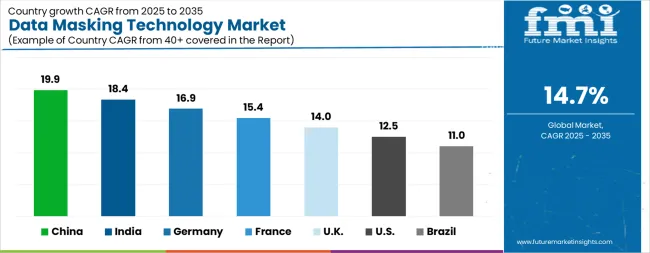
| Country | CAGR |
|---|---|
| China | 19.9% |
| India | 18.4% |
| Germany | 16.9% |
| France | 15.4% |
| UK | 14.0% |
| USA | 12.5% |
| Brazil | 11.0% |
The Data Masking Technology Market is expected to register a CAGR of 14.7% during the forecast period, exhibiting varied country level momentum. China leads with the highest CAGR of 19.9%, followed by India at 18.4%. Developed markets such as Germany, France, and the UK continue to expand steadily, while the USA is likely to grow at consistent rates. Brazil posts the lowest CAGR at 11.0%, yet still underscores a broadly positive trajectory for the global Data Masking Technology Market. In 2024, Germany held a dominant revenue in the Western Europe market and is expected to grow with a CAGR of 16.9%. The USA Data Masking Technology Market is estimated to be valued at USD 423.0 million in 2025 and is anticipated to reach a valuation of USD 1.4 billion by 2035. Sales are projected to rise at a CAGR of 12.5% over the forecast period between 2025 and 2035. While Japan and South Korea markets are estimated to be valued at USD 53.2 million and USD 40.1 million respectively in 2025.
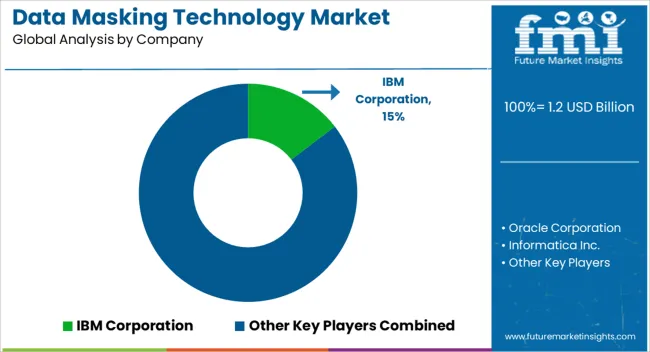
| Item | Value |
|---|---|
| Quantitative Units | USD 1.2 Billion |
| End-User Vertical | BFSI, Retail, Telecomm, Health Care, Energy, Education, Automobile, Public Sector, and Others |
| Deployment Models | ETL, In-Place Masking, and Dynamic Masking |
| Regions Covered | North America, Europe, Asia-Pacific, Latin America, Middle East & Africa |
| Country Covered | United States, Canada, Germany, France, United Kingdom, China, Japan, India, Brazil, South Africa |
| Key Companies Profiled | IBM Corporation, Oracle Corporation, Informatica Inc., Delphix Corp., Mentis Inc., Innovative Routines International Inc., Solix Technologies Inc., K2View Ltd., Redgate Software Ltd., Broadcom Inc. (CA Technologies), Protegrity USA, Inc., and TokenEx, LLC |
The global data masking technology market is estimated to be valued at USD 1.2 billion in 2025.
The market size for the data masking technology market is projected to reach USD 4.5 billion by 2035.
The data masking technology market is expected to grow at a 14.7% CAGR between 2025 and 2035.
The key product types in data masking technology market are bfsi, retail, telecomm, health care, energy, education, automobile, public sector and others.
In terms of deployment models, etl segment to command 36.8% share in the data masking technology market in 2025.






Our Research Products

The "Full Research Suite" delivers actionable market intel, deep dives on markets or technologies, so clients act faster, cut risk, and unlock growth.

The Leaderboard benchmarks and ranks top vendors, classifying them as Established Leaders, Leading Challengers, or Disruptors & Challengers.

Locates where complements amplify value and substitutes erode it, forecasting net impact by horizon

We deliver granular, decision-grade intel: market sizing, 5-year forecasts, pricing, adoption, usage, revenue, and operational KPIs—plus competitor tracking, regulation, and value chains—across 60 countries broadly.

Spot the shifts before they hit your P&L. We track inflection points, adoption curves, pricing moves, and ecosystem plays to show where demand is heading, why it is changing, and what to do next across high-growth markets and disruptive tech

Real-time reads of user behavior. We track shifting priorities, perceptions of today’s and next-gen services, and provider experience, then pace how fast tech moves from trial to adoption, blending buyer, consumer, and channel inputs with social signals (#WhySwitch, #UX).

Partner with our analyst team to build a custom report designed around your business priorities. From analysing market trends to assessing competitors or crafting bespoke datasets, we tailor insights to your needs.
Supplier Intelligence
Discovery & Profiling
Capacity & Footprint
Performance & Risk
Compliance & Governance
Commercial Readiness
Who Supplies Whom
Scorecards & Shortlists
Playbooks & Docs
Category Intelligence
Definition & Scope
Demand & Use Cases
Cost Drivers
Market Structure
Supply Chain Map
Trade & Policy
Operating Norms
Deliverables
Buyer Intelligence
Account Basics
Spend & Scope
Procurement Model
Vendor Requirements
Terms & Policies
Entry Strategy
Pain Points & Triggers
Outputs
Pricing Analysis
Benchmarks
Trends
Should-Cost
Indexation
Landed Cost
Commercial Terms
Deliverables
Brand Analysis
Positioning & Value Prop
Share & Presence
Customer Evidence
Go-to-Market
Digital & Reputation
Compliance & Trust
KPIs & Gaps
Outputs
Full Research Suite comprises of:
Market outlook & trends analysis
Interviews & case studies
Strategic recommendations
Vendor profiles & capabilities analysis
5-year forecasts
8 regions and 60+ country-level data splits
Market segment data splits
12 months of continuous data updates
DELIVERED AS:
PDF EXCEL ONLINE
Data Security Posture Management (DSPM) Solutions Market Size and Share Forecast Outlook 2025 to 2035
Data Loss Prevention (DLP) Services Market Size and Share Forecast Outlook 2025 to 2035
Data Pipeline Observability Solutions Market Size and Share Forecast Outlook 2025 to 2035
Data Center Market Forecast and Outlook 2025 to 2035
DataOps Platform Market Size and Share Forecast Outlook 2025 to 2035
Masking Tape Market Size and Share Forecast Outlook 2025 to 2035
Datacenter Infrastructure Services Market Size and Share Forecast Outlook 2025 to 2035
Data Acquisition Hardware Market Size and Share Forecast Outlook 2025 to 2035
Data Center Automatic Transfer Switches and Switchgears Market Size and Share Forecast Outlook 2025 to 2035
Data Discovery Market Size and Share Forecast Outlook 2025 to 2035
Data Centre Rack Server Market Size and Share Forecast Outlook 2025 to 2035
Data Center Power Management Industry Analysis in Western Europe Size and Share Forecast Outlook 2025 to 2035
Data Center Power Management Industry Analysis in Korea Size and Share Forecast Outlook 2025 to 2035
Data Center Liquid Cooling Market Size and Share Forecast Outlook 2025 to 2035
Data Business in Oil & Gas Market Size and Share Forecast Outlook 2025 to 2035
Data Centre Colocation Market Size and Share Forecast Outlook 2025 to 2035
Data Lake Market Size and Share Forecast Outlook 2025 to 2035
Data Center RFID Market Size and Share Forecast Outlook 2025 to 2035
Data Center Accelerator Market Size and Share Forecast Outlook 2025 to 2035
Data Lakehouse Market Size and Share Forecast Outlook 2025 to 2035

Thank you!
You will receive an email from our Business Development Manager. Please be sure to check your SPAM/JUNK folder too.
Chat With
MaRIA